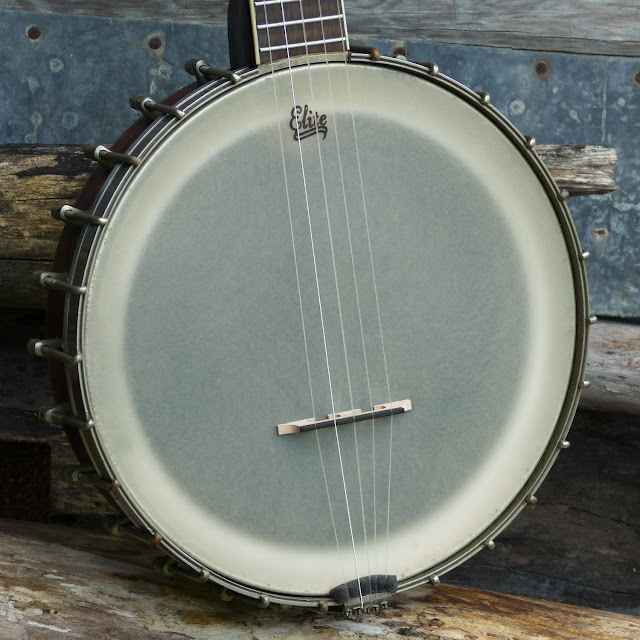1910s Vega-made Bacon Professional FF 5-String Banjo
Earlier, 5-string Bacon banjos are on the pretty-dang-rare side, and this is one of the very-hip "double-wall-rim" models with the Bacon-style "donut" tonering installed. It sounds excellent (I'm a huge fan of "donut" tonerings) and I'm pretty sure the responsibility for said excellence is due to its manufacture by Vega in Boston. The serial number on the side of the dowel points to production between 1910 and 1915-ish.
A customer brought this in and it was in funky shape when it arrived. The neck was warped like crazy, a 5th peg tuner hole was ripped-up, half-refilled, and left as-is, the whole thing had been refinished, the nut slot was missing a nut and had been monkeyed-with, and it needed a good going-through. My work included a board plane and refret, a new head, a new bone nut, replacement 5th peg, new bridge, and much finagling to get it into submission as a player.
The new 11" Elite head (Remo Renaissance) is translucent so the shape of the big old donut-style tonering is on view. I love the direct, snappy, elegant tone of these rings.
The fretboard is stained maple and due to that, it was prone to chipping. Fortunately, the board level and refret went smoothly. I had to replace a couple of pearl dots in the board as one leveled right out and the other was missing.
My new 5th peg is a Grover friction type, but I modified a vintage button to fit on it so it'd match the headstock tuners.
The bridge is a straight-up 1/2" Grover. A minstrel-style bridge would've added more snap, but this one gives a bit more mwah to the tone.
The banjo was definitely refinished a dark color in its past. I'm wondering if it was originally a blonde.
These "FF" models have a very cool "double-walled" rim that sort-of deflects the tone a bit like a resonator. I think that, mostly, it looks neat.
Amazingly, all of the original hardware save the 5th peg was extant. That's quite rare on an old banjo.
The neck doesn't align on-center, so this bit of hokey finagling was necessary. It works, however, so I'm not going to complain too much. It's pretty common for the necks to go off-center as the rims and necks change on the instrument. I didn't want to involve my poor customer in a recut of the heel itself (she wasn't aware it needed the refret), so this was a practical decision.
I happened to have a neck brace in my parts-bins that fit. I bought it in a set of braces a long time ago and I'm glad I had one for this fella. The thick rim precluded me from also hidden-bolting the neck in addition, so a sturdy neck brace was a must.






















Comments